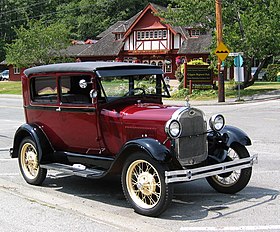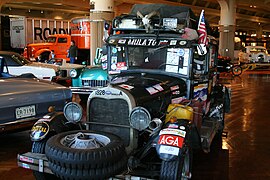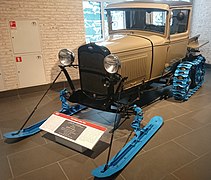Ford Model A (1927–1931)
| Ford Model A | |
|---|---|
 1928 Ford Model A Tudor sedan | |
| Overview | |
| Manufacturer | Ford Motor Company |
| Also called | GAZ A (USSR) |
| Production | October 1927 – March 1932 |
| Model years | 1928–1931 |
| Assembly |
|
| Designer | Henry Ford Edsel Ford |
| Body and chassis | |
| Class | Full-size Ford |
| Body style | A – Chassis Convertible sedan (400A) Business coupe Coupe Deluxe coupe Special coupe (1928–29 limited run) Ford or coupe Deluxe coupe sedan – MurrayStandard Fordor sedan – Briggs Deluxe Fordor sedan – Murray Deluxe Fordor sedan – Briggs Leatherback Fordor sedan Standard Fordor sedan – slant windshield Mail truck Panel truck Phaeton 2-door Phaeton 4-door Cabriolet Pickup Deluxe pickup Standard roadster Roadster utility Deluxe roadster Sport roadster Station wagon Town car Town car delivery Standard Tudor sedan Deluxe Tudor sedan Ford Model 18 |
The Ford Model A (also colloquially called the A-Model Ford or the A, and A-bone among
By February 4, 1929, one million Model As had been sold, and by July 24, two million.[8] The range of body styles ran from the Tudor at US$500 (in grey, green, or black) ($8,872 in 2023 dollars[9])[8] to the town car with a dual cowl at US$1,200 ($21,293 in 2023 dollars [9]).[10] In March 1930, Model A sales hit three million, and there were nine body styles available.[8]
Model A production ended in March 1932, after 4,858,644 had been made in all body styles.
Features
Prices for the Model A ranged from US$385 for a roadster to US$1,400 for the town car. The engine was a water-cooled L-head inline four with a displacement of 201 cu in (3.3 L).[12] This engine provided 40 hp (30 kW; 41 PS).[12] Top speed was around 65 mph (105 km/h). The Model A had a 103.5 in (2,630 mm) wheelbase with a final drive ratio of 3.77:1. The transmission was a conventional unsynchronized three-speed sliding-gear manual[12] with a single speed reverse. The Model A had four-wheel mechanical drum brakes.[12]
The Model A came in a wide variety of styles including
The Model A was the first Ford to use the standard set of driver controls with conventional clutch and brake pedals, throttle, and gearshift. Previous Fords used controls that had become uncommon to drivers of other makes. The Model A's fuel tank was situated in the cowl, between the engine compartment's fire wall and the dash panel. It had a visual fuel gauge, and the fuel flowed to the carburetor by gravity. A rear-view mirror was optional.
The Soviet company GAZ, which started as a joint venture between Ford and the Soviet Union, made a licensed version from 1932–1936.[14]
In Europe, where in some countries cars were taxed according to engine size,
Development history
From the mid-1910s through the early 1920s, Ford dominated the automotive market with its Model T. However, during the mid-1920s, this dominance eroded as competitors, especially the various General Motors divisions, caught up with Ford's mass production system and began to better Ford in some areas, especially by offering more powerful engines, new convenience features, or cosmetic customization.[18][19][20]
Ford's sales force recognized the threat and advised Henry to respond to it. Initially, he resisted, but the T's sagging market share finally forced him to admit a replacement was needed. When he finally agreed to begin development of this new model, he focused on the mechanical aspects and on what today is called
It was during the period from the mid-1920s to the early 1930s that the limits of the first generation of mass production, epitomized by the Model T production system's rigidity, became apparent. The era of "flexible mass production" had begun.[23][24]
Legacy
The Model A was well-represented in the media of the era since it was one of the most common cars.
Several models have obtained particular fame. The Mean Green Machine, a green and black 1931 Tudor sedan, has been a staple of
Jenny Railcars

The West Side Lumber Company of California converted several Model As into railcars which could carry 12 people. A few still see regular service on the Yosemite Mountain Sugar Pine Railroad, also in California, alongside Shays Nos. 10 and 15.[27]
Gallery
-
Hector Quevedo's 1928 Model A on display at the Henry Ford Museum
-
1928 Model A Fordor with a 1941 Kaiser wood gas generator[28]
-
1928 Model A hot rod with roll pan, chopped top, and late-model headlights and mirrors
-
1928 Model A business coupe
-
1929 Model A Gazogene on display at the Tampa Bay Automobile Museum. This car was modified in 1939 to use an alternative fuel in the form of wood or charcoal.
-
1929 town car from the Museum of Automobiles in Arkansas
-
1929 Model AA heavy-duty truck variant of the Model A
-
1931. Ford Model A, Snow Flyer
-
Hot rod with 1931 roadster body and chassis,[citation needed] Deuce grille shell, chrome-hatted carburetors, drilled I-beam dropped front axle, finned drum brakes, and zoomie pipes
References
- ^ a b c d e f g h i j k l "FORD'S CAR OUTPUT 1,200 TO 1,500 DAILY". The New York Times. March 23, 1928.
- ^ "Ford Assembly Denver Colorado". Hemmings Motor News. American City Business Journals. Retrieved February 20, 2021.
- ^ "Ford of Canada plant — railway cars brought the parts that were assembled into complete vehicles | Winnipeg Regional Real Estate News". Winnipegrealestatenews.com. Retrieved August 23, 2022.
- ^ García, Gerardo (June 24, 2020). "29 fotos históricas para recordar a la primera fábrica de autos en México: producía 25 Ford Model T al día en 1925" [29 historical photos to remember the first car factory in Mexico: it produced 25 Ford Model T per day in 1925]. Motorpasión (in Spanish). Mexico. Retrieved January 15, 2024.
- ^ ISBN 0-87341-428-4.
- ^ Bianco, Johnny, "Leadfest" in Rod & Custom, 9/00, p. 86.
- ISBN 9781610608886.
- ^ a b c Gauld, p. 693.
- ^ a b 1634–1699: McCusker, J. J. (1997). How Much Is That in Real Money? A Historical Price Index for Use as a Deflator of Money Values in the Economy of the United States: Addenda et Corrigenda (PDF). American Antiquarian Society. 1700–1799: McCusker, J. J. (1992). How Much Is That in Real Money? A Historical Price Index for Use as a Deflator of Money Values in the Economy of the United States (PDF). American Antiquarian Society. 1800–present: Federal Reserve Bank of Minneapolis. "Consumer Price Index (estimate) 1800–". Retrieved February 29, 2024.
- ^ Gauld, p. 694.
- ^ "Model A Production Figures". Model A Ford Club of America. December 30, 2008. Retrieved April 12, 2015.
- ^ ISBN 1840136359.
- ^ "Directory Index: Ford/1930_Ford/1930_Ford_Brochure_02". Oldcarbrochures.com. Retrieved November 20, 2011.
- ^ Sorensen 1956, pp. 206–208.
- ISBN 3-87943-519-7
- ^ Clutton, Cecil, Paul Bird and Anthony Harding. The Vintage Car Pocketbook; The Motoring Encyclopaedia (1935?)
- ^ "0 – 100...We celebrate a century of Ford in style...". Auto Express (724): 56–62. October 2–8, 2002.
- ^ Sorensen 1956, pp. 217–219.
- ^ Hounshell 1984, pp. 263–264.
- ^ Sloan 1964, pp. 162–163.
- ^ Hounshell 1984, pp. 280–292.
- ^ Hounshell 1984, pp. 280–281.
- ^ Hounshell 1984, pp. 263–301, Chapter 7: Cul-de-sac: The Limits of Fordism & the Coming of "Flexible Mass Production".
- ^ Sorensen 1956, pp. 217–231, Chapter 16: Farewell to Model T.
- ^ Cardinale, Anthony. "Chileans on a Roll in Vintage Car Trek Detroit-Bound Model A Ford Arrives Here After 21,700 Miles". Buffalo News. Buffalo, N.Y.: November 30, 1994, p. A.1.
- ^ "Dillinger's getaway car sells for $165,000". CNN Money. January 24, 2010. Retrieved January 12, 2024.
- ^ "Yosemite Mountain Sugar Pine Railroad Bounces Back After Railroad Fire". KVPR Valley Public Radio. October 18, 2017. Retrieved November 20, 2022.
- ^ Daniel, Hagen. "Der Ford Model A mit Holzvergaser". holzgas.ch. Retrieved October 12, 2021.
Bibliography
- OCLC 1104810110
- ISBN 978-0385042352).
- ISBN 9780814332795.
- Gauld, Graham. "The Ford Motor Company", in Northey, Tom, ed. World of Automobile, Volume 6, pp. 681–700. London: Phoebus, 1974.
Further reading
- Henry, Leslie R. (2013). How to Restore the Model A Ford. Vermont: Echo Point Books & Media, LLC. ISBN 978-1626549418.
External links
- Model A Ford Reference Sheet, Owners Manual, and Help
- Model A Ford Club of America - [1]
- Model A Restorers Club - [2]
- Ford Model AA Truck Club - [3]
- A-Ford Club Nederland - [4]
- Ford Model A at Curlie
- Follow Henry As We Tour The Long Beach Assembly Plant circa 1930[permanent dead link]
- Ford Model A Assembly Plant in Edgewater NJ
- Fordbarn, An active forum for discussion about the Model A Ford
- 365 Days of A, One man's quest to drive a Ford Model A for an entire year.
- 1930 Model A sales brochure


![1928 Model A Fordor with a 1941 Kaiser wood gas generator[28]](http://upload.wikimedia.org/wikipedia/commons/thumb/c/c7/Ford_Model_A_1928_Wood_Gas_01.jpg/240px-Ford_Model_A_1928_Wood_Gas_01.jpg)






![Hot rod with 1931 roadster body and chassis,[citation needed] Deuce grille shell, chrome-hatted carburetors, drilled I-beam dropped front axle, finned drum brakes, and zoomie pipes](http://upload.wikimedia.org/wikipedia/commons/thumb/e/ee/%2731_Ford_Model_A_%28Auto_classique%29.JPG/239px-%2731_Ford_Model_A_%28Auto_classique%29.JPG)